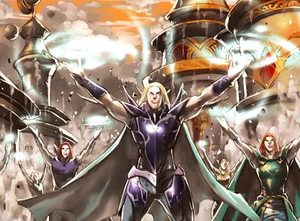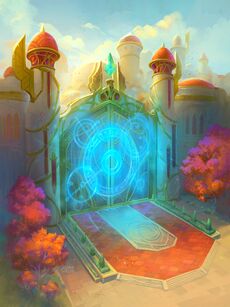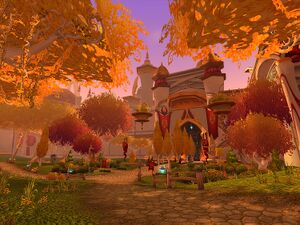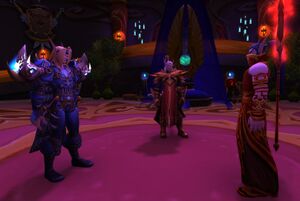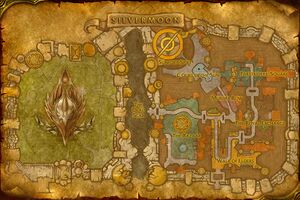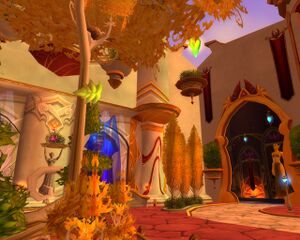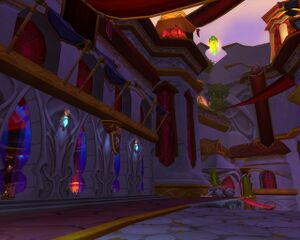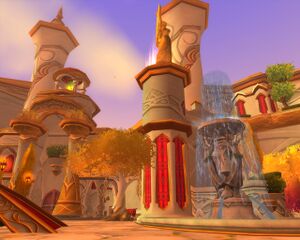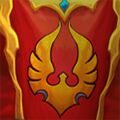Silvermoon City
- This article is about the elven city. For the in-game faction of the same name, see Silvermoon City (faction).
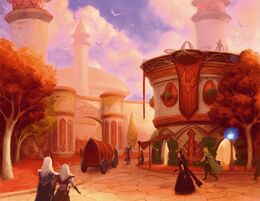 | |
| Type | Capital city |
| Races |
|
| Formerly |
|
| Government | Regency (de facto Monarchy) |
| Ruler(s) |
|
| Former ruler(s) |
|
| Languages | Thalassian, Common, Orcish, Zandali, Taur-ahe, Goblin, Shalassian |
| Faiths | Sun, Holy Light |
| Affiliation | Kingdom of Quel'Thalas, Horde |
| Former affiliation(s) | Alliance of Lordaeron |
| Location | Northern Eversong Woods |
| PvP status | Horde territory |
| Status | Active |
“The glorious Silvermoon City has been home to the elven population of the Eastern Kingdoms for millennia.”
- — Explorer's Guild Guide to the Eastern Kingdoms[1]
Silvermoon City (or the City of Silvermoon[2] and just Silvermoon) is the crown jewel of the blood elves, once the high elves, and the capital city of the kingdom of Quel'Thalas. It is nestled in the northern reaches of the Eversong Woods (at the northernmost tip of the Eastern Kingdoms) in their ancestral homeland of Quel'Thalas. The city guards the way to the Sunwell, and as such is of strategic importance to the kingdom.[3] The beauty of its spires and thoroughfares stand in stark contrast to the Dead Scar, the tainted path that the Scourge tore through the city during the Third War. Though nearly destroyed by Arthas Menethil's attack on the Sunwell, Silvermoon was rebuilt by the Magisters and became once again a thriving city,[4] while the western half of it still remains in ruins since the Scourge invasion. Following the Battle for Quel'Danas, the rebirth of the Sunwell has lifted spirits among the sin'dorei, and they have since continued to heal Silvermoon's scars in the hopes of returning their beloved capital to its former glory.[3]
According to the sin'dorei themselves, Silvermoon City is unrivaled in beauty or grandeur.[5] Its majestic spires reflect their boundless elegance, creativity, and craftsmanship.[3]
History
Early history
The city of Silvermoon was founded around 6,800 BDP by the exiled Highborne under the leadership of Dath'Remar Sunstrider, who had traveled from Kalimdor to the northern forests of Lordaeron seeking a new homeland. Using a stolen vial from the Well of Eternity, Dath'Remar created the sacred Sunwell, a fount of arcane power that would be inherently tied to his people for generations to come. Nourished by the arcane energy from the Sunwell,[6] he led the Highborne in the magical construction of their new capital, raising its spires and buildings with their great magical power. Silvermoon itself was constructed over the site of sacred troll grounds,[5] which earned the elves further enmity from the neighboring Amani tribe. The city was constructed primarily out of radiant white stone and adorned with crimson tapestry.[7]

The Highborne, now calling themselves the high elves, thus founded the kingdom of Quel'Thalas. Under the rule of the Sunstrider dynasty and the Convocation of Silvermoon, the ruling body of the highest elven lords, they created marvelous works and bathed their land in eternal springtime. Their capital Silvermoon became a shining monument to the memory of the elves' ancient empire[8] as the kingdom's crowning jewel, and was renowned for its grand libraries and seats of magical learning.
Strengthened by a Sunwell-empowered shield named Ban'dinoriel ("Gatekeeper" in Thalassian) which interconnected at ley lines throughout the land, Silvermoon was well-protected from would-be invaders. The elves constructed all manners of arcane indulgences over the years, including runestones to protect their lands, crystals to power their experimentations,[9] and brooms that constantly sweep their streets, which would be useful if anyone could figure out how to make them stop.[10]
For millennia, Silvermoon City stood strong in the face of several conflicts such as the Troll Wars in 2,800 BDP, perpetrated by the vengeful Amani Empire (whom the high elves had banished after their exodus to Quel'Thalas). For months after the cessation of the conflict, celebrations graced the streets of Silvermoon City and Strom,[11] the human capital of the Arathorian Empire with whom they allied against the trolls. In the aftermath, Silvermoon established a long-lasting friendship with the city-state of Dalaran, which lasted for over 2,000 years.[12] Due to their considerable lifespans, it was not uncommon for elves to study magic in Dalaran as well as Silvermoon (some elves claim to have spent several human lifetimes in service to both), though the reverse was less true: Silvermoon gained a reputation for isolationism over the years, a consensus emerging among many high elves that exposing the humans to magic was a mistake to begin with.[13]
From its founding to the Third War (a period of roughly 7,000 years),[3] Silvermoon had never fallen.[14]
Second War
- Main article: Burning of Quel'Thalas
During the Second War, the Amani entered into an alliance with the Old Horde, on the condition that the orcs help displace the elves from Quel'Thalas. Silvermoon itself was left relatively unscathed thanks to Ban'dinoriel, which erected a magical barrier over the city making it impervious to the Horde's dragon fire, though the trolls launched a heavy offensive into Eversong Forest and in some cases came close to the capital. The city also had the protection the runestones provided, whose mysteries proved difficult even for the practiced orc warlocks to decipher. The Amani had spent many years trying to torture information regarding the runestones out of captured elves in the hope of using them to subvert Silvermoon's defenses, to no avail.
Prior to the burning of Quel'Thalas, the orc Gul'dan used the power of the Altars of Storms to break through Ban'dinoriel's protection. As the Altars were crafted from the elves' own runestones, which were originally powered by the Sunwell, the warlock thought to use that link in reverse, sending his own magic into their power source and either destroying it or wresting it away from them.[15] The Old Horde forces then stormed towards Silvermoon City, and while General Turalyon organized the Alliance forces, the elven ranger Alleria Windrunner met with High King Anasterian Sunstrider who held court in Sunstrider Spire. There, he and the Convocation of Silvermoon swore to end the Amani remnants once and for all, and pledged the full support of Quel'Thalas to the Alliance of Lordaeron.[16]
During the course of the battle, the Old Horde sent their enslaved red dragons to burn the forests of Quel'Thalas. The roaring firestorm caused most of the elf defenders to seek shelter in Silvermoon, and since they had no physical weapons that could stop their enemies from invading the elven capital, their elf sorcerers had to summon an immense shield deriving its power from the Sunwell itself around the capital.[16] After failing to breach Silvermoon City, Warchief Orgrim Doomhammer pulled his forces back and ordered them to march west, towards Capital City, leaving the Stormreaver, Twilight's Hammer, and Dragonmaw clans behind to help the Amani with the siege. Warlord Zul'jin promised Doomhammer that he would join him in Lordaeron after Silvermoon was destroyed, but that would never come to pass.[17]
With the aid of the Alliance forces, the high elves eventually pushed the remaining invaders back from Silvermoon and successfully dispersed the orcs and Amani by the end of the war.
Despite this victory, the high elves and their allies entered into a period of mutual coldness after the war's end.[18] Seeing little value in remaining part of the Alliance (and reasoning that the Alliance needed his people more than his people needed the Alliance), High King Anasterian seceded his nation on the grounds of poor leadership on the humans' end, which he claimed led to unnecessary violence within his borders.[19] The elven capital thus went back into seclusion, its people issued with edicts to enforce this withdrawal.[20] Silvermoon then remained relatively peaceful for years, though this was not to last.
Fall of Quel'Thalas
- Main article: The Scourge invasion of Quel'Thalas
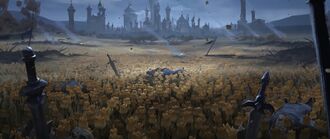
During the Third War, the massive undead Scourge army under the command of Arthas Menethil, fresh from laying Lordaeron to waste, marched to Quel'Thalas in order to defile the Sunwell. As the commander of all of Quel'Thalas' military forces, Ranger-General Sylvanas Windrunner ordered most of the kingdom's magi and priests to gather in Silvermoon City, where they would serve as the last line of defense if the Scourge made it to the capital.[21] In the end, Sylvanas's sacrifice had been valiant, but it did not save Silvermoon from its fate.
Since its foundation, the elven capital was protected by a number of magical barriers. Two were the elfgates, which were positioned at strategic points on the main road to the capital, while the most powerful barrier was Ban'dinoriel. The Scourge might have never bypassed these defenses if not for the high elf magister Dar'Khan Drathir, whose limitless ambition, combined with his egotistical mindset, made him an easy pawn. Empowered by Arthas, Dar'Khan betrayed his people for the power he had always craved and opened the way for the Scourge to ravage his homeland.[22]
After tearing through Eversong Forest and overcoming the Farstriders' attempts to hold back his advance, Arthas reached Silvermoon and demanded the elves open their gates and allow him passage. Refusing to surrender, the high elven forces rallied under the command of Grand Magister Belo'vir, who took over the defense of Silvermoon in the fallen ranger-general's place. The archers, magi, priests, and Dragonhawk riders did what they could to ward off the undead, though they were faced with impossible odds. Knowing the city would not hold for much longer, Belo'vir had Archmage Rommath evacuate as many civilians as he could, and the remaining soldiers left to make a stand with High King Anasterian and the bulk of the Magisters on the Isle of Quel'Danas.[14] Silvermoon fell soon after their departure. The city was sacked, overrun with undead, and set ablaze.[23]
After Arthas succeeded in resurrecting Kel'Thuzad as a lich from its tainted remains, defiling the Sunwell in the process, he had no more reason to linger and left Quel'Thalas in ruins. He nevertheless left behind him large pockets of undead with a raised Dar'Khan at their head. The war's outcome was devastating: 90% of the high elves had been slain, including Anasteriasn, Belo'vir, Sylvanas, and the entire Convocation. In the aftermath, Ranger Lord Lor'themar Theron gathered as many survivors as he could, and took over the Bazaar to serve as a point of congregation for others who had survived the attack. Rommath also soon returned to search for the living, clearing out groups of Scourge with his powerful magics.[14]
Rise of the sin'dorei
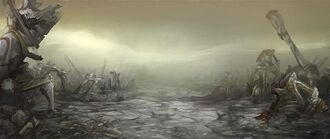
Following the decimation of the high elves, Prince Kael'thas Sunstrider rushed back to his people in Quel'Thalas. Arriving in Silvermoon, the survivors greeted him with thinly veiled resentment. The prince made no excuses for being absent in Quel'Thalas's hour of need, as his people had every right to be bitter. After he surveyed Silvermoon City's ruins, Kael paid his respects to his father, whose body had been returned to the city. He later organized a strike team of fighters to help destroy the corrupted Sunwell, now pulsating with tainted energies that threatened to destroy both the elves and the land itself.[24] Returning to Silvermoon, Kael renamed his people the "blood elves" in honor of their many fallen brethren. Their king was then cremated on a funeral pyre in the Bazaar.[14]
Prince Kael'thas later took several of his most powerful followers to fight the Scourge across Lordaeron. He commanded the ranger lord Lor'themar Theron to safeguard the kingdom in his absence,[25] but also to find a cure for the elves' innate addiction to magic, which had become apparent in the wake of the well's destruction. The blood elves back in Quel'Thalas made little progress with this goal, drained and exhausted without the Sunwell for sustenance. The already overstretched Farstriders also made little dent in the remaining Scourge pockets.[14]
In time, the repercussions of the Sunwell's destruction continued to unfold as its energies scattered across the land. The red dragon Korialstrasz discovered this unprotected magic and was deeply concerned that it would draw the attention of differing factions and ignite a conflict. After he scoured the ravaged lands around Silvermoon City, he gathered every scrap of power he could and molded a human avatar named Anveena Teague.[26]
A few years later, despite his secret allegiance to the demon lord Kil'jaeden, Kael'thas still cared for his people and decided that the naaru M'uru he captured at Tempest Keep power could sate the elves' cravings for magic. However, his people had mixed feelings and were troubled by the idea of leeching energy from a being of Holy Light. On the other hand, Magister Astalor Bloodsworn and his followers chose to experiment on the naaru for months until they learned how to force out its holy energies to wield the Light themselves. In addition to their traditional Magisters and Farstriders, the blood elves expanded their power base with the Blood Knights, a group of paladins under the lead of Lady Liadrin.[14][27]
The Burning Crusade
Following the events of The Sunwell Trilogy, Lor'themar Theron and Halduron Brightwing were approached by a contingent of Magisters sent back to Quel'Thalas. Led by Rommath, the magi shared with their people the radical new teachings of Illidan Stormrage (smoothly attributed to Kael'thas), leading to the weary blood elves becoming reinvigorated. Under the new Grand Magister's command, the magi quickly went about reclaiming and rebuilding much of Silvermoon City "almost overnight," their great magical powers making quick work of the Scourge.[28] Silvermoon City was reconstructed in an elaborate manner, once more becoming a beacon of magic and power in the Eastern Kingdoms.[5] The towering spires of Silvermoon rose skyward once again, and the entire eastern section of Silvermoon has been wholly reclaimed by the sin'dorei. The western portion, however, remains lost for the time being, though the blood elves have recently turned their attention to healing it too.
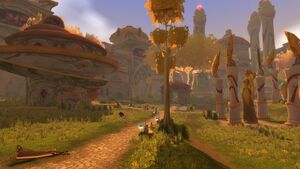
During the rebuilding, a great deal of demonic energy had been used to fully empower the city.[29] Chained fel crystals, full to the top with harnessed magic, doted the elven city and powered up all the various magical contrivance, including many floating spires and castles. It is important to note that the demonic nature of the crystals within Quel'Thalas was not disclosed to the blood elf public, as the Magisters were aware that its citizens would not embrace fel magic as their desperate brethren on Outland had.[28] Since the blood elves were cut off from the rest of civilization by the dangerous Plaguelands, an Orb of Translocation has been made connecting Silvermoon to Undercity.
Following the induction of the kingdom into the New Horde, a group of ambassadors from each race of the faction were sent to inspect Silvermoon and ascertain their goals. While Ambassador Kelemar guided them through the streets of the capital, discussing the magical properties of the city and the benefit of having the sin'dorei as allies, the unusual political climate nevertheless prevented the envoys from meeting the regent lord.
After Kael'thas was defeated in Tempest Keep, the mad prince returned to Quel'Thalas and briefly attacked Silvermoon with his felblood minions. Retaking M'uru from its chambers, Kael'thas set the stage for his final stand on the Isle of Quel'Danas.[30] Lady Liadrin witnessed her prince's attack on Silvermoon herself; and now without a power source for the Blood Knights, she traveled to Shattrath to meet with A'dal. She learned that M'uru had resigned himself to this fate a long time ago, and pledged the blades of the Blood Knights to ending the prince's dark ambitions, and restoring Silvermoon to its glory.[31]
During the course of the invasion of Outland, magically-automated guardians constantly remind everyone in the city of the blood elves' leader and savior, Prince Kael'thas, by reciting lines of carefully-worded propaganda. This helped prevent the blood elven denizens of the city from forgetting to whom they owe their absolute loyalty. However, after Prince Kael'thas betrayed his people for the Burning Legion, the Arcane Guardians have been changed to reflect Kael'thas' betrayal and gave propaganda referring to Lor'themar Theron as the savior of the blood elves instead. Additionally, the Silvermoon City Guardians critiqued by Champion Vranesh no longer praised Kael'thas as the "Sun King".
With the restoration of the Sunwell, a bright future lied ahead for Quel'Thalas. The blood elves turned their attention to healing the western half of Silvermoon and restoring the city to its former glory.[3]
Cataclysm
Following the Cataclysm, The Reliquary building was opened in the capital.
Mists of Pandaria
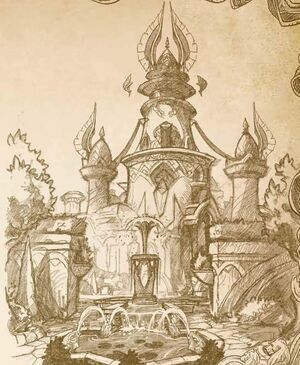
During the Alliance-Horde war, an artifact from Pandaria was shipped to Silvermoon by Warchief Garrosh Hellscream, who tasked the blood elves with learning more of it. Adventurers of the Horde were later sent there to correspond with Lor'themar Theron himself, who had set Grand Magister Rommath to the task of deducing its modus operandi. The artifact was stored under the Hall of Blood, where several of Rommath's magisters were magically probing it. The Regent Lord also called in the leader of the Sunreavers, Aethas Sunreaver, to lend his aid to the experiment, which nearly resulted in a sha being released in the city. During the experiment, Rommath also confirmed that the fel crystals once around Silvermoon have since been removed.[12]
Following the Purge of Dalaran, the escaped Sunreavers were funneled back to the safety of Silvermoon.[32]
A portal was later created between the city and the Dawnseeker Promontory on the Isle of Thunder.
War Crimes
While the trial of Garrosh Hellscream was taking place in Pandaria, the city was visited by Zaela and Shokia who came to recruit Archmage Thalen Songweaver, who had returned to live his luxurious apartments in the Royal Exchange since his actions during the Attack on Theramore Isle. He then left Silvermoon to join the True Horde in a mission to rescue the former warchief of the Horde.[33]
Legion
During the Burning Legion's third invasion, portals were created between Silvermoon and Suramar. The blood elven forces arrived to Meredil from the city.
Since the Nightfallen rebellion and Thalyssra's rise to power, Silvermoon and Suramar maintained good relations. Lor'themar Theron, seeing much in common between the sin'dorei and shal'dorei kingdoms, invited their new leader to Silvermoon for a visit; Thalyssra soon after pledged her nation to the Horde. The regent also entertained Alleria Windrunner, who had come in an attempt to convince Silvermoon to leave the Horde and ally with the Alliance, but this offer was rejected. Alleria instead sought out exiles from Silvermoon who had been banished for dabbling in the Void, which the blood elf leaders consider a threat to the Sunwell.[34][35]
Battle for Azeroth
Among her reasons for capturing the world tree Teldrassil, Warchief Sylvanas Windrunner stated that the Alliance would use it as a safe harbor to transport Azerite from Kalimdor to the Eastern Kingdoms. She also expected that, under High King Anduin Wrynn's orders, Azerite would be used to create powerful weapons to attack Silvermoon and Undercity.[36]
Each year, Silvermoon holds a ceremony of remembrance for those who fell during the Scourge invasion of Quel'Thalas. During the course of the Fourth War, Lor'themar summoned a sin'dorei champion to undertake it, taking a lantern imbued with the light of the Sunwell to key locations throughout the kingdom to reenact the defense of Quel'Thalas and honor the sacrifices made in its darkest hour. The ceremony began and ended in Silvermoon City, where the champions were awarded the heritage of the sin'dorei regalia by the regent lord himself.[37]
Exploring Azeroth
Following the armistice, Silvermoon was visited by Flynn Fairwind and Mathias Shaw in their cartography of the Eastern Kingdoms; the Horde Council gave the pair permission to visit Horde lands unaccosted. Fairwind reflected on the blood elves' history and marveled at the beauty of their city, grateful to have visited it, while Shaw traveled to Quel'Danas to see the Magisters' Terrace.[38]
A Whisper of Warning
Sometime after the war against the Primalists, Regent Lord Lor'themar Theron briefly rescinded Alleria's banishment so that she could apprise her son, who had taken up residence in Silvermoon, of her mission to pursue the Dark Heart. Placed under a watchful escort of Silvermoon City guardians, the void elf was given until sundown to conduct her business. Silvermoon's citizens were affrighted by and distrustful of Alleria for her link to the Void and consequent threat to the Sunwell. High Exarch Turalyon, who had independently visited Silvermoon to consult with Lady Liadrin, reunited with his wife and son before their departure for the Walk of Elders, the Royal Exchange, Farstriders' Square, and the Court of the Sun. While much of Silvermoon had been restored to its glory, the reconstruction was yet ongoing.[39]
Appearance
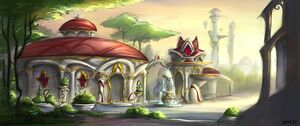
Silvermoon, like most of Quel'Thalas, borrows heavily from the Art Nouveau style. Its extravagances are copious and the city blends the natural and the magical together, with many open plots of grass and trees (many of which are styled, presumably magically, in impossible ways) around the city. Silvermoon has many statues within its walls, the most common depicting Prince Kael'thas Sunstrider and a regal female of unknown identity. Others depict hooded female rangers and poised magistrixes. The city favors golds, whites, and reds, as it did 7,000 years ago.[40] Silvermoon's banner is a gold phoenix on a red background.[41]
When asked about the capital's decorations, including arcane frippery, floating objects, and the use of magic for what appear to be frivolous things, Ambassador Kelemar replied that these choices aim to be a visible demonstration of the power that the sin'dorei hold. While they remain mindful of their resources, they can afford to spend their magic on simple aesthetic enhancements, since they hold a vast reservoir of power at their disposal. More than just a beautification measure, its also a morale booster for their own people, demonstrating that they have a great deal of power at their fingertips to do nearly anything. In the end, it is an understandable expenditure to show everyone, enemies and allies alike, that they are not afraid to use their power.[42]
The city's appearance could be seen as reflective of the blood elves' own psyche. The blood elves are trapped in a struggle with their hunger for magic, caught between mastering this desire or letting it master them, and the duality of Silvermoon reflects their inner struggle. One side ruined, one side restored to its former glory; magnificent on the outside, lingering darkness on the inside.[43] However, the truly interesting insights reveal themselves when players look closer at what is going on in Silvermoon City. Beyond the luscious avenues, behind the rich billowing curtains, lie dark and gloomy interiors, and those who explore the other side of Silvermoon City may find that the city's beautiful facade serves only to hide the true, more-sinister side of the city.
Notable characters
- Main article: Silvermoon City NPCs
Since the death of High King Anasterian Sunstrider during the Third War, and Prince Kael'thas' betrayal to the Burning Legion, Lor'themar Theron acts as the Regent Lord of Quel'Thalas and the current leader of the blood elves on Azeroth. He is supported in his tasks by Ranger-General Halduron Brightwing, who acts as the military leader of Quel'Thalas and leader of the Farstriders; but also advised by Grand Magister Rommath who leads the Magisters, the blood elves' traditional order of magi.
Prior to the Battle for Quel'Danas, M'uru was the naaru that the blood elves captured and used as the source for the Blood Knights' holy powers. He could previously be found beneath the Hall of Blood, where it was watched over by Magister Astalor Bloodsworn, responsible for the project, and Lady Liadrin, who volunteered to be the first ever blood knight. The naaru was eventually kidnapped and taken to the Sunwell Plateau where he served as a 25-man raid boss.
Silvermoon is uniquely adorned by a number of interactive lore events, most of which allude to the politics and factions of Quel'Thalas and its people. Several Blood Knights can be seen speaking of their order's predicament and future, such as Initiates Colin and Emeline. Champion Vranesh can be seen patrolling the city, eliciting the respect of the guard force and showing a low opinion for his Farstrider brethren. In turn, the Farstriders can be seen discussing their own outlook, referencing more healthy methods by which to keep the country safe.
Quests
- Main article: Silvermoon City quests
Geography
The inhabited half of the city is arranged into separate but linked areas that each carry a unique feel.
The Shepherd's Gate
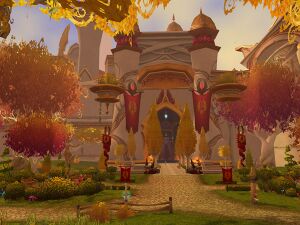
The Shepherd's Gate is the main (and only) conventional entrance to Silvermoon, decorated by a towering statue depicting the likeness of Prince Kael'thas Sunstrider. An equally large entrance paves the way to the western half of Silvermoon, though this leads only to the town of Falconwing Square; the western portion of the city itself having yet to be reclaimed. The Shepherd's Gate overlooks much of Quel'Thalas, with colorful gardens to its front and a bulk of blood elven guards to its back.
Though the Shepherd's Gate holds the distinction of being the only practical entrance to Silvermoon, two others are still in existence: the Orb of Translocation at the back of the royal palace, which offers a teleport to the Ruins of Lordaeron, and a massive gate to the west of the Bazaar. However, said gate is closed and guarded, presumably due to the drawbacks a back entrance could prove, and the fact that the blood elves' control of western Silvermoon is perhaps not yet strong enough to warrant another gate to match the Shepherd's.
The Walk of Elders
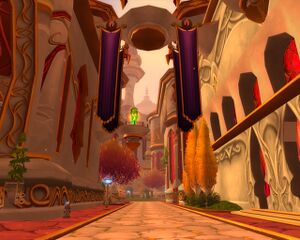
- The Walk of Elders
- Silvermoon Registry (guild services and tabard vendor)
- Velaani's Arcane Goods (alchemy reagents and wand vendors)
The Walk of Elders offers the first glimpse to the blood elves' beauteous capital. Magical ornaments adorn the streets, while the autumn-touched trees found within Quel'Thalas grow here, too, albeit on a smaller scale, and clash neatly with the rest of the city and its red, gold, and autumn-bathed complexion. Rows of benches shrouded in crimson curtains are slashed across the Walk of Elders, perfect for a moment of respite.
The Walk of Elders is also the central point of the city, connecting its neighbors to the east, north, and west. It houses several profession trainers, and offers a back entrance to a magisters' lounge named the Mana Loom in the eastern court of The Royal Exchange. Also of note is the presence of the sin'dorei's Horde allies in the Walk of Elders; Harene Plainwalker on hand for druid training and Gez'li for shaman, just north of Velaani's Arcane Goods. The celebrated Tauren Chieftains are currently within the blood elven capital too, resting in a spire just east of the Walk's entrance and right of the Silvermoon Registry.
The Bazaar
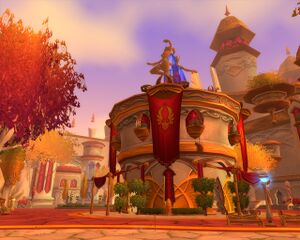
- The Bazaar
- Wayfarer's Rest (one of the two inns)
- The Bank of Silvermoon (one of the two banks)
- Shields of Silver (shield armoury)
- Keelen's Trustworthy Tailoring (tailoring profession lounge)
- Silvermoon Finery (cloth and bag merchants)
The Bazaar is the primary trading area of the city, housing one of its two sets of auction houses along with all of the other practical essentials any sin'dorei could need: an armory, a weapons' barracks, a bank and a collection of other useful services among them. The Bazaar also houses one of the several inns around the city, named Wayfarer's Rest (a popular spot for roleplaying), with enough elaborately-conjured and appetizing food and drink to sate one's hunger and thirst for as long as need be.
Outside, a colossal fountain neatly nestles itself in the center of the Bazaar, while a gathered crowd in the far-western zone tends to two dissidents, whose anti-magisters rhetoric takes a conspicuous change in tone after one such magister casts a spell on the pair. Conjurer Tyren also begins his rounds in the Bazaar, lighting up the sky with several magical indulgences.
Also of wry amusement in the Bazaar is the Keelen's Trustworthy Tailoring shop, whose neat work appears to be a dubiously kind front after visiting the leper gnomes employed beneath its main lounge. Silvermoon Finery is on hand for any cloth-related needs a sin'dorei may have.
The Royal Exchange
- The Royal Exchange
- The Hall of Respite (a magisters' lounge)
- Silvermoon Jewelery (jewelcrafting trainers and supplies)
- The Reliquary (headquarters of the Reliquary; archaeology trainers)
- Royal Exchange Bank (the second bank within Silvermoon)
The Royal Exchange is a larger variation of the Bazaar, though perhaps without the dedicated trading theme. Though with both an auction house and a bank, the Royal Exchange is large enough to house a number of other points of interest, in addition to its glittering fountain surrounded by domesticated cats, rabbits, and magically-imbued broomsticks to sweep the streets.
The magisters have a room of their own on show, housing a demonic crystal that several magisters can be seen siphoning now and again. The blood elven Reliquary also has its base of operations here, though its denizens maintain that their vault, treasure, artifacts, and secrets are not -- perhaps not even on "this plane of existence." On the opposite side are the jewelrcrafting trainers, who were for a long while the only ones on Azeroth.
Murder Row
- Murder Row
- Silvermoon City Inn (the second inn within Silvermoon; Wayfarer's Rest being the other)
- The Sanctum (warlocks' guild)
As the name attests, Murder Row is a more sinister take on Silvermoon, though its adjacent inn to The Royal Exchange would not suggest it. On the other side, however, lies the rogue and warlock masters and mistresses of the sin'dorei.
Within The Sanctum resides numerous blood elven warlocks, and an eerie collage of demonic crystals kept out of sight of the general public. Here, warlocks drain their power effortlessly, surrounded by those of like-minded goals. Above is the rogues' section of the city, seemingly spearheaded by Instructor Cel; housing a considerable training ground and a chance to stock up on poisons and other rogue essentials for trips out of Quel'Thalas.
An interesting observation in Murder Row is of the warlock Keyanomir, whose succubus minion will only come out after dark.
Farstriders' Square
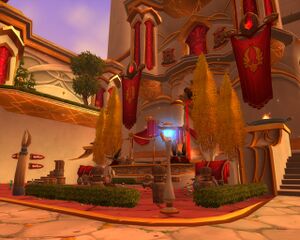
- Farstriders' Square
- The Rangers' Lodge (Farstrider lounge; hunter trainers)
- The Hall of Blood (Blood Knight headquarters; paladin trainers; battlemasters)
Farstriders' Square is the section of the city allocated to the Farstriders and the Blood Knight order, though the two groups seem to keep their distance. Though the main Farstrider lodges are found outside of Silvermoon (such as Farstrider Retreat), they have a humble lodge named The Rangers' Lodge in the northern section. The Blood Knights hold the more formidable section of the city, however, from the intimidating Hall of Blood. Here, the Blood Knights make their presence known, under heavy guard and with most of their leadership found within; notably missing only their matriarch, Lady Liadrin, who traveled to Shattrath in order to gain another source of power for the order. The Hall of Blood also houses Silvermoon's battlemasters, Alenjon Sunblade and Irissa Bloodstar. Beneath once resided the captive naaru M'uru, though following his abduction to the Sunwell only Astalor Bloodsworn, several magisters, and Liadrin's second-in-command Lord Solanar Bloodwrath remain there.
Outside is the main practice ground, where Farstriders hone their skills and heroes can follow suit, thanks to the training dummies. The blood elven warriors stand vigil over the square, spearheaded by Alsudar the Bastion. The engineering and blacksmithing trainers are also found within the square, surrounded by arbalests.
Court of the Sun
The Court of the Sun is the northernmost area of Silvermoon, excluding the royal palace. Decorated by the largest of the three fountains within the city at its center (a practical bathing house in terms of sheer size), the Court of the Sun looms over both Farstriders' Square and Murder Row. In addition to its beauty, it also houses the remaining profession trainers within the city, including reforging.
From the court, the full glory of the towering spires of Silvermoon can be seen -- not least of all surging skywards from the royal palace ahead.
Sunfury Spire
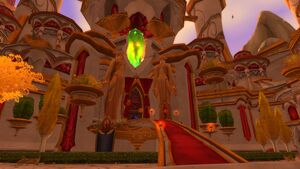
Sunfury Spire is the royal palace of Silvermoon, where the regent lord of Quel'Thalas Lor'themar Theron holds court with the Ranger-general of Silvermoon, Halduron Brightwing, and the Grand Magister of Quel'Thalas, Rommath. The spire was built after the previous royal palace, named Sunstrider Spire, was destroyed during the Scourge attack. A thick bridge with a crimson-red royal carpet paves way to the royal palace, with two large rows of Silvermoon City Guardians standing vigil outside. Decorated by two towering statues, a number of Quel'Thalas emblems, and the considerably large guard force within, the Sunfury Spire is unmistakable.
To the left after entering the spire lies the sin'dorei priesthood trainers, while the magisters train new members of the order to the right; the portal to the Blasted Lands found within the magisters' portion of the spire too. Straight ahead lies the leaders of Quel'Thalas, surrounded by their Royal Guard force. Behind Lor'themar sits his cobalt-colored throne, a large phoenix symbol fastened to its back.
Behind the royal palace lies the Inner Sanctum, where teleportation to the Ruins of Lordaeron awaits.
Other locations
Points of interest
- Main article: Silvermoon City points of interest
The following points of interest are to be found in Silvermoon City:
- Two banks
- Two auction houses
- Two inns
- 10 mailboxes
- The flight master can be found outside the city gates
- An Orb of Translocation in the Inner Sanctum of Sunfury Spire, allowing instant teleportation to Undercity.
Travel connections
Flight
Note: Silvermoon can be reached via flight path from the rest of the Eastern Kingdoms if you have met the Eastern Plaguelands flight master, Georgia, at Light's Hope Chapel.
Teleport
In the RPG
Unlike the rest of the Blackened Woods, the former elven capital of Silvermoon is not as devastated. The city almost resembles its old splendor as the living plants and rock used to construct the capital proved immune to the fires and destruction. Trees and buildings still stand and if you walked the city streets you would be surprised as how clean the place appears. Aside from the occasional body sprawled across the cobblestones, one could almost imagine that a war was never fought there.
Silvermoon's ruined buildings were constructed of white stone and living plants. Slender branches and ivy snake across walls. Many of the plants are dead now, the buildings smashed and the spires toppled. Nevertheless, much still remains intact. The city is not as ruined as one would suspect and is surprisingly nearly devoided of rotting corpses, bloodstains and similar filth. Silvermoon, however, is a deceptive death trap.
Undead elven guardians and ghosts wander the streets and towers, ensuring that no more harm befalls their city. No living beings inhabit this region, though the lure of elven treasure draws adventurers from far and wide. The Sunstrider Spire palace still hides the legendary Sunstrider treasury.[44][45]
Silvermoon was the high elven capital for centuries since the Quel'dorei traveled to this land from Kalimdor. Like the rest of Quel'Thalas, enemies despoiled and razed the city in the Second and Third Wars, though Silvermoon survived the flames. Scourge forces held the city for a time but abandoned it after depleting it of its resources. Silvermoon now reminds us of everything that was once noble and mystical about the high elves — and how that nobility died.[46]
Notes and trivia
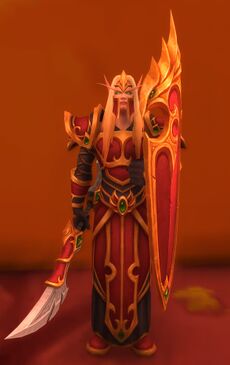
- Along the northern coast, there were docks which the Scourge demolished.[14]
- The old main gate of the city was completely destroyed during the Third War, and the Shepherd's Gate is used in its stead.
- The stable master Shalenn tends the animals within the city and prevents them from running amok while their masters continue to fritter their lives away.[47]
- Silvermoon today is only the eastern half of the original city; the western half was almost completely destroyed by the Scourge during the Third War. Falconwing Square, the second blood elf town, is the only part of western Silvermoon remaining in blood elf control. The Dead Scar (the path taken by Arthas Menethil and his undead army on the quest to resurrect Kel'Thuzad, which carves through all of Eversong Woods) separates the rebuilt Silvermoon from the ruins of the western half. Interestingly, the Ruins of Silvermoon house no undead, instead they contain Wretched and malfunctioning Arcane Guardians.
- Silvermoon has a meeting hall at the north end of its palace, where the regent lord and his advisors (chiefly Halduron and Rommath) discuss matters of state and politics. It is a large and impressive chamber designed specifically for this purpose; it also overlooks the ocean, and the Isle of Quel'Danas is visible from it.[48] Whether this is the main hall of the Sunfury Spire seen in-game, or another, unseen part of the palace, is unclear.
- Silvermoon also has a number of grand libraries not specifically seen in-game. Loremaster Skosiris of the Scryers sought to imitate them in the Seer's Library.
- The city's guards, "Silvermoon City Guardians" use a distinctly different model than other male blood elves, made to resemble the Spellbreakers of old Quel'Thalas with tall shields and large glaives. This model is based on an older blood elf player model from The Burning Crusade's pre-alpha builds, which were in use at the time of the expansion's announcement at Blizzcon.
- It was mentioned in a behind-the-scenes The Burning Crusade interview that Silvermoon's architecture was originally held together by magic from the Sunwell and that when the Sunwell was destroyed, the buildings began to deteriorate into what we now see in the Ruins of Silvermoon. It was said that without the Sunwell's great energies, the magi had to rebuild the city using demonic magics.[29] Whether this is still the case with the Sunwell restored and the removal of the fel crystals is unclear, if unlikely.
 [Ilterendi, Crown Jewel of Silvermoon] is a legendary paladin ring in World of Warcraft: Legion.
[Ilterendi, Crown Jewel of Silvermoon] is a legendary paladin ring in World of Warcraft: Legion.- The female blood elf /silly emote, "You mean, I'm STUCK with this hair color?!" seems to be, in principle at least, quite accurate; as there is no barber shop in Silvermoon City, those blood elves wishing to change their character models must visit another city to do so.
- As a tribute to the first blood elf to hit level 67 during the beta, the paladin trainer Bachi was named after the player Bachi.
- Silvermoon's name may have been inspired by Silverymoon, a capital city in the Forgotten Realms lore.
Speculation
This article or section includes speculation, observations or opinions possibly supported by lore or by Blizzard officials. It should not be taken as representing official lore.
|
Etymology
Silvermoon's name is peculiar in that the elves, who had renounced their nocturnal ways and embraced the sun, would go on to name their capital city after the moon. Why this is, when even their naming conventions changed to incorporate the sun and brightness/light over the moon and darkness, is unknown. It's possible Dath'Remar felt a twinge of sentimentality for the culture he was in the process of changing and chose to keep but one prominent reminder of where the Highborne had come from.
It was mentioned in the Warcraft Chronicle that Silvermoon became a "shining monument to the memory of the (Highborne's) ancient empire." This might imply that it was named to emphasize that connection; the Highborne were moon-worshipping night elves during the height of their old empire.
Gallery
Silvermoon City prior to the Third War.
- World of Warcraft
The Icon of Blood, the crest of Silvermoon and Quel'Thalas.
Silvermoon City in The Burning Crusade.
The Walk of Elders
The guild master's building in the Walk of Elders.
The Bank of Silvermoon within the Bazaar.
The tailoring trainer's building in the Bazaar.
The Wayfarer's Rest, the second inn of Silvermoon.
The Murder Row
The entrance to the Hall of Blood, the Blood Knights headquarters.
The Court of the Sun
The Inner Sanctum incorporates the device teleporting to Undercity.
The Winter Veil in Silvermoon.
The Dead Scar splitting the city in half.
Silvermoon artwork by Jimmy Lo.
See also
References
- ^ Silvermoon City
- ^
 [Sealed Note]
[Sealed Note]
- ^ a b c d e World of Warcraft Races - Blood elf
- ^ World of Warcraft Factions - Silvermoon City
- ^ a b c Ultimate Visual Guide, pg. 148
- ^ World of Warcraft: Exploring Azeroth: The Eastern Kingdoms, pg. 92
- ^
 [Ilterendi, Crown Jewel of Silvermoon]
[Ilterendi, Crown Jewel of Silvermoon]
- ^ World of Warcraft: Chronicle Volume 1, pg. 121
- ^


 [1-10] Reclaiming Sunstrider Isle
[1-10] Reclaiming Sunstrider Isle
- ^ Companion Collections description of
 [Enchanted Broom]
[Enchanted Broom]
- ^ World of Warcraft: Chronicle Volume 1, pg. 131
- ^ a b
 [15-35] What's in the Box?
[15-35] What's in the Box?
- ^
 [Quel'Thalas Registry]
[Quel'Thalas Registry]
- ^ a b c d e f g Blood of the Highborne
- ^ Tides of Darkness, chapter 15
- ^ a b World of Warcraft: Chronicle Volume 2, pg. 164
- ^ World of Warcraft: Chronicle Volume 2, pg. 165
- ^ Beyond the Dark Portal, pg. 60
- ^ The Warcraft Encyclopedia/Anasterian Sunstrider
- ^ Warcraft III manual description - Elven Priests
- ^ World of Warcraft: Chronicle Volume 3, pg. 61
- ^ World of Warcraft: Chronicle Volume 3, pg. 63
- ^ The Well of Eternity, chapter 1
- ^ World of Warcraft: Chronicle Volume 3, pg. 88
- ^ World of Warcraft: Chronicle Volume 3, pg. 90
- ^ World of Warcraft: Chronicle Volume 3, pg. 103
- ^ World of Warcraft: Chronicle Volume 3, pg. 144 - 145
- ^ a b The Warcraft Encyclopedia/Blood Elves
- ^ a b 4:30 Burning Crusade Behind the Scenes DVD
- ^ World of Warcraft: Chronicle Volume 3, pg. 159
- ^ Lady Liadrin#Meeting with A'dal
- ^
 [15-35] One Last Grasp
[15-35] One Last Grasp
- ^ War Crimes, chapter 17
- ^
 [40-70] Silvermoon City
[40-70] Silvermoon City
- ^
 [40-70] Remember the Sunwell
[40-70] Remember the Sunwell
- ^
 [110] The Warchief Commands
[110] The Warchief Commands
- ^


 [50-70] The Pride of the Sin'dorei quest line
[50-70] The Pride of the Sin'dorei quest line
- ^ Exploring Azeroth: The Eastern Kingdoms, pg. 88-94
- ^ A Whisper of Warning
- ^ Sean Copeland on Twitter (10 Apr 2014) [dead link]
- ^
 [Silvermoon City Banner]
[Silvermoon City Banner]
- ^ Horde Emissaries#Silvermoon City decorations
- ^ Anatomy of a City: Silvermoon
- ^ Lands of Conflict, pg. 114
- ^ World of Warcraft: The Roleplaying Game, pg. 22
- ^ Lands of Conflict, pg. 115
- ^ [[Silvermoon City Guardian#Gossip
- ^ In the Shadow of the Sun, pg. 1
External links
| Silvermoon City | Scenario |
|---|---|
| ||||||||||||||||||||
| ||||||||||||||||||||||||||||||||||||||||||||||||||||||||||||||||||||||||||||||||||||||||||||||||||||||||||||||||||||||||||||||||||||||||||

